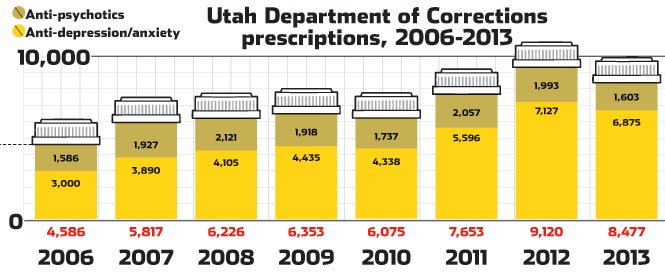Mental Lockdown
Mentally ill inmates struggle while the prison tries to prescribe their problems away
By Stephen Dark @stephenpdark and Eric S. Peterson @ericspetersonBy the time Ryan Allison was 21, he had a few goals for his life. He wanted to be a chef, get married and have children. But he also faced some challenges.
"I've never lived on my own," he told a parole-hearing officer at the Utah State Prison. "I've never had a job in my life, I don't know how to read directions."
That's because for the previous 10 1/2 years of his life, Allison had spent only eight months outside of locked-down institutions.
And 18 months after sharing his modest ambitions, Allison was dead.
After at least 10 attempts to kill himself while serving five years in Draper prison for threatening a judge, the 22-year-old Allison took his own life by diving head-first from a sink or toilet fixture in a suicide-watch cell in the prison's mental-health unit.
Allison's life and death, says Disability Law Center legal director Aaron Kinikini, "is pretty typical of what happens when all the moving parts of the criminal justice system do what they do when somebody with mental illness is thrown into it; it's a complete cluster from start to finish."
Allison spent over half of his first three years in prison in solitary confinement. Solitary was the only safe place for him, according to the prison, but it also functioned as punishment for his infractions of prison rules. The DLC, which represented Allison in his last years, calculated in a report that 71 percent of Allison's "misbehavior was punished with solitary confinement," and two-thirds of the incidents for which he was punished "were related to his mental illness."
The problem is, Kinikini says, that punishment only works for inmates who understand the carrot-and-stick philosophy. "Compliance with prison rules is going to be problematic when you don't have much meaningful control over your actions," he says.
And because mental-health programming is an inconsistent "patchwork," Kinikini says, county jails and the state prison become the de facto warehouses for the mentally ill in Utah and the rest of the nation.
Which is why Allison—who was featured with three other mentally ill inmates kept in solitary in a 2012 City Weekly cover story—is far from rare in Utah's jails and prison.
"There's more Ryan Allisons in the corrections system than we would care to acknowledge," Kinikini says.
The DLC found from Allison's prison records that it was very rare for him to see a psychiatrist—the prison has only one. As for the mental-health workers who "visited" him—speaking through the slot of his cell door—Kinikini says, "If you ask inmates, they would say, 'They give us pills. They're not therapists, they just write scrips.' "
Indeed, between 2006 and 2013 (the most recent year of complete data) a total of 14,942 anti-psychotic medications were prescribed within Utah's two prisons, an average of almost 1,800 a year. Those rates have remained relatively steady over the years, but other drugs have seen more significant increases. In 2006, there were 57 prescriptions for anti-anxiety medications, compared with 461 in 2013. In that same time period, prescriptions for anti-depressants have more than doubled—going from 2,943 in 2006 to 6,413 in 2013.
The prison, through spokeswoman Brooke Adams, says a change in psychiatrists "may have influenced prescriptions issued." Other factors she cites as potential explanations for the rise in prescriptions include an increase in the number of inmates with mental-health issues, offenders being treated for mental illness outside the prison prior to incarceration, and the growth in the prison population from just under 6,000 in 2005 to almost 7,000 in 2013.
Adams says 16 percent of the prison population—roughly 7,000 inmates—have serious mental illnesses. That's more than 1,100 inmates, overseen by approximately 40 clinical staff members. But Olympus, the mental-health unit generally reserved for "severe, persistent mentally ill inmates" has only 168 beds and currently houses 143 inmates, Adams says. Mental health's budget is "a large portion," Adams says, of the Clinical Services budget, which is roughly $31 million, of which $1.9 million is for "mental illness-related and psychotropic drugs."
These numbers go straight to the heart of what will be one of the biggest issues on the Hill during the 2015 legislative session—a bold effort to revamp the prison and its programming as part of the Legislature's plans to relocate the state prison, which currently sits in Draper.
The Pew Charitable Trust, in collaboration with the Utah Commission on Criminal & Juvenile Justice, recently told lawmakers that reforms could help contain nearly 100 percent of the costs of future prison growth, shaving off over half the cost of the $1 billion price tag associated with relocating the prison.
The Legislature's desire to relocate the prison presents a unique opportunity to make a once-in-a-lifetime investment in criminal-justice reform—dollars not just for a new prison, but for a new system, one that could build a network of credible community-treatment resources to perhaps keep future Ryan Allisons from winding up as grim statistics.
Passing this legislation will be an uphill battle in the 2015 Legislature, but a coalition of advocates, nonprofits and agencies—especially the Department of Corrections—are optimistic that now is the time to pass these reforms.
Due to the ongoing investigation into Allison's death, the prison can't comment on his history at corrections. But public defender Heather Chesnut, who represented Allison shortly before his death, calls him "a prime example of the lack of mental-health facilities we have in our system. He was at the prison because we didn't have anywhere to put someone like him."
RYAN ALLISON TIMELINENOW OR NEVER
Rep. Eric Hutchings, R-Kearns, has been on the appropriations committee tasked with funding corrections programs for the past 13 years and has chaired the committee for the past six. His committee has always been the redheaded stepchild when it comes to funding priorities—until now.
Hutchings says the nearly $1 billion "sticker shock" associated with moving the prison has already set in, so now is the time to finally mobilize an added investment to rework the system from top to bottom.
"We're not talking about just the buildings only; we're talking about the entire system," Hutchings says. "Everything outside the fence and everything inside the fence."
Hutchings will be sponsoring legislation in the 2015 session bringing forward reforms developed by the Utah Commission on Criminal & Juvenile Justice and the Pew Charitable Trust that will be crucial in containing future prison growth.
Community-treatment programs could offer a variety of services: group homes that segregate offenders by the severity of their illnesses, or programs tailored to different demographics. The importance of community treatment is providing an environment where therapy and medication can offer a path to normalcy—instead of a setting where pills are paired with solitary confinement and the harsh existence of trying to find mental wellness while behind bars.
But if that means investing tens of millions into community treatment resources for individuals with substance-abuse disorders and mental illnesses, Hutchings says, it has to be done right, with treatment centers following evidence-based standards.
In the case of community treatment, the bill's reforms would call for standardized certification for treatment centers looking for funding and evidence-based results—without which he doubts the Legislature would fund community programs.
"If we don't come up with good numbers, this whole thing just dries up and disappears," Hutchings says.
The other political barrier is convincing legislators that these reforms aren't about going soft on criminals but about reconsidering who really is a public-safety threat in our criminal justice system.
"There's definitely [cases] for having very thick walls and very tough bars on it, but there's also an awful lot of people that just screw up," Hutchings says. "They're just like 'Help me, I'm not a bad guy, I just blew it.' And there are some people, quite frankly, especially with mental-health issues, that it's not even a choice for them."
Other states are already seeing positive results for the mentally ill and for taxpayers by funding more community resources.
Since 2007, Colorado's legislature has provided special criminal-justice funding to its counties for community-based services for juveniles and adults with mental illnesses. In fiscal year 2013-2014, the majority of Colorado's community treatment centers reported improvements in wellness of 1,387 clients served. Taxpayers saw relief, too: That year, $3.2 million of funding for community resources translated into over $19 million in savings for keeping these clients from being treated in prison, jails and community correctional centers.
The program's administrator, Jagruti Shah, says this community-based intervention makes sense not just in Colorado, but nationwide.
"Are we going to continue to fund more jails or prisons or expansions, or are we going to try and keep these clients out, and offer them services in less restrictive areas where it's cheaper to do these services?" Shah says.
MORE HELP THAN ANYONE CAN GIVE
From his birth, Allison was unwanted. According to his records, public defender Chesnut recalls, he was "subjected to a very heavy drug-use environment" as an infant and passed from one person to another without the stability of any basic care. Allison came to Utah when he was 4 years old after he and his sister were adopted by a family that moved to Utah County from California.
According to a 14-page document compiled by the Disability Law Center from prison records and Allison's letters to them, from an early age he showed "conduct and impulsive control problems; as a result he was placed in several juvenile residential programs." When he turned 18, Allison wrote, he was placed in a Utah County foster home "for people with drug, gang and problems with violence."
Four months after his 18th birthday, in April 2010, he huffed some Axe body spray to get high and grabbed a steak knife from the kitchen. After a brief altercation over a social event his new foster family was attending, he pulled the knife and threatened his cousin with it, then ran off, subsequently surrendering to police.
That got him a misdemeanor charge of threatening to use a dangerous weapon in a fight. Once in the criminal justice system, he would never get out.
While being held in Utah County jail, he used an intercom in his cell to tell a guard that he would kill the judge on his case for talking about sending him to prison. The threat earned him a felony charge, and on Nov. 3, 2010, he pleaded guilty but mentally ill before Judge Claudia Laycock, who sentenced him to five years in prison. But she found that his mental illness "poses an immediate physical danger to himself or to others [...] if placed in a correctional or probation setting," so she sent him to the state hospital in Provo for treatment.
Things did not go well. In a 2012 letter to City Weekly, he wrote that he attacked staff and patients, broke chairs, closets and shelves and fire sprinklers. The act that led to him being sent back to Utah County jail in March 2011 was trying to break the neck of a patient at the hospital who had trash-talked him.
Laycock ruled that the Department of Corrections was "the correct placement for Mr. Allison," so she reinstated the five-year prison sentence. "This is a young man who needs more help than you and I can provide for him," she wrote to the parole board. "Unfortunately, the prison is the last resort for a defendant with his violent and disturbed background. He will need highly intensive supervision when placed on parole."
Allison never made it to parole. The third day of his prison sentence, Allison attempted suicide by taking 40 pills from a prescribed blister pack. The prison ruled he was guilty of abusing and misusing medications and gave him 10 days in solitary confinement in Uinta 1.
In his first year in the prison, 13 of the 15 incidents he was punished for with punitive isolation "were likely related to Ryan's mental illness," the DLC wrote.
Allison wrote to City Weekly of his experience struggling for recovery in Uinta 1, where he endured lockdown nearly 24/7 in a single cell.
He was allowed out for a 15-minute shower every other day and one hour in a caged outdoor space—"a rec yard." Transporting him to this space required him to be handcuffed, put on a leash, and wear a spithood. He got one hot meal a day, the other two meals being baloney sandwiches, with carrots and an orange.
After continued threats of suicide, Allison hanged himself in August 2011 and was found by officers "gasping for air." He told a mental-health official he had tried to kill himself, the DLC report notes, because the hallucinated voices "were constantly telling him that no one loves him, that he is a fat, disgusting and worthless human being who needs to kill himself and who should do so as soon as possible,"
The more time he spent in solitary, the more his mental-health issues worsened—which, in turn, led to more suicide attempts and self-harming so he could go to the infirmary.
Allison was more than aware of his own self-destructive impulses. In a Nov. 11, 2012, letter to the DLC, Allison explained that an inmate's slide into suicidal thoughts and actions stem from struggling with the prison environment, regret over how they came to be incarcerated and shame for making their family look bad.
"These 3 reasons are [why] I attempted suicide," he wrote. "When we attempt suicide here at the prison we are punished. And as you can see we can end up receiving Punitive isolation time."
Allison was on multiple medications. But, according to a February 2012 note by a clinical services worker in Allison's file, his medication "mostly cause sedation, but do little to help his mood."
Sam Vincent, who treats the mentally ill homeless at Fourth Street Clinic, worked at the prison between 2008 and 2009. Mental-health clinicians who work at the prison are "heroic," he says, doing the best they can with the resources they have. In front of someone clawing at their face with their fingernails, he says, a chemical restraint "seems the humane thing to do."
Clinicians also have what Vincent calls "a tightrope walk" to get buy-in from officers to treat mentally ill inmates' behavior as symptoms rather than misbehaving.
He says the increasing number of prescription medications at the prison might reflect national trends in the use of psychiatric medications over the last decade. "Meds are used to replace therapy in the private sector as well as in corrections," he says. "Our culture is encouraging people to look for a pharmacological fix for emotional problems."
CLOSING THE GAP
Pat Fleming, the director of Substance Abuse Services for Salt Lake County Behavioral Health, sees access to that money—$258 million—as crucial to building up community treatment programs in the counties that can intervene before individuals go to prison and, ideally, when they get out.
"I've got a four-month waitlist to get someone into a residential bed in Salt Lake County," Fleming says. "I'm like the king of rationing behavioral health care—it's a terrible spot to be in."
With Medicaid expansion, Fleming says, programs in Salt Lake County could, for example, afford to separate low and high-level offenders in community-treatment programs, a targeted approach that's been shown to improve outcomes.
Medicaid expansion would also provide an incredible opportunity to individuals who regularly cycle in and out of the criminal justice system. At a recent criminal justice reform symposium, Jeannie Edens of the Salt Lake County Department of Behavioral Health Services shared statistics showing that, prior to the implementation of the Affordable Care Act, Utah was in line with the rest of the nation, in that 90 percent of individuals entering county jails are uninsured.
Providing coverage to this population would also be a major relief for taxpayers, Edens noted, as the cost of two years of outpatient treatment is equivalent to 90 days incarceration or 19 days of a hospital stay. Beyond that, Medicaid expansion could finally provide resources for ex-convicts in the community to make them "into taxpayers, not tax users."
LET ME OUT
At least three times during his first three years in prison, Allison did achieve a measure of stability and pursued both vocational training and finishing his high school credits.
Graduating from high school was something that made him immensely proud, but Allison remained a fragile case. In 2012 alone, he had approximately 151 mental-health visits, though the majority of them, according to prison records, were what the DLC describes as "Direct Observation, or at his cell door within earshot of other inmates or guards," with the health visitor speaking through a slot.
In early 2013, Allison's behavior in Uinta 1 deteriorated yet again. "He mentioned that he cannot return to U1 as life there will be unbearable," a mental-health official wrote in his file. "I took the time to explain (as has repeatedly been done) that if he behaved, he could leave there permanently."
Despite such admonitions, Allison pulled most of his hair out of his head, some strand by strand. He beat his face against the cell window when talking to a health visitor. "He reports that he will 'do anything,' " a report by a clinical-services worker states, to get out of Uinta 1, the maximum-security wing, and over to Olympus, the mental-health unit of the prison. Prison staff viewed such behavior dubiously. "I suspect this activity is borderline and manipulation." In March and April 2013, as his stress over an upcoming parole-board hearing grew, he inflicted horrific injuries upon himself. "Last month I did the following," he wrote to the DLC. "I ripped my own Anus open with my own hand's, I hung myself, I tried to drown myself in the toilet, I jumped off the sink backward's headfirst, I broke 3 finger's on my left hand with my own Right hand," he tried to hit several infirmary officers, and as he was put on a gurney after he hung himself, "I was trying to bite a chunk out of my own hand."
Allison went before the parole-board chairman, Clark Harms, in April 2013. He told Harms how he wanted to have a life, any life, rather than where he was then. Harms told him he couldn't be paroled until he was stable.
The cocktail of meds he was on did not stop Allison from hanging himself multiple times, he told Harms. "I hear voices and they tell me to do bad things," he said.
As soon as Allison left Harms, despite having agreed to behave better, he hanged himself. A few weeks later, he received Harms' recommendation that if he had no write-ups in six months, he might be eligible for parole. But since he had already tried to kill himself, that meant he had a write-up on his record and at that point, he later told a hearing officer, "I gave up."
DEAD END
Six months after seeing Clark Harms, Allison went before mental-health hearing officer Jan Nicol. She told him that both the institution and the executive director of the prison had recommended he not be released.
Allison wasn't surprised. He told Nicol that, "When I get angry, I get to the point where I don't care about anything and I go off." She explained to him that while his violence might be sparked by officers trash-talking him, "really all you're doing is punishing yourself."
She noted that Allison probably couldn't see her because he was not allowed glasses after breaking up his last pair and, at the suggestion of another inmate, swallowing the pieces in an attempt to perforate his bowels.
His sentence would end in May 2015, she told him. "I would really like you to have help," she said.
But that help never came. Allison attempted to castrate himself, spurred on by child-abuse issues from when he was an infant, according to what he wrote to a prisoner-rights advocate. That had earned him lockdown in a mental-health strip cell in the Olympus unit, he wrote.
In August 2014, Allison went to court on charges relating to assaulting two corrections officers by spitting at them. Four to six prison officers in full riot gear accompanied him, public defender Chesnut says.
He was found guilty but mentally ill and given a five-year prison sentence to run concurrently with the sentence he was close to finishing.
By then, Allison's aspirations had changed from being a chef. He told Chesnut he would "never be able to openly live in public because he was too dangerous to himself and other people." She says he hoped one day to be well enough to live in a group home. "I think he would have done anything to get rid of his insanity."
One month later, on Sept. 12, 2014, Ryan Allison succeeded in taking his own life in a suicide-watch cell in Olympus, the mental-health unit. Staff gave him CPR to no avail. He was 22.
It's unlikely Allison was aware of the political maelstrom swirling around the prison with calls for reform and funding for community services. Inside the prison, Allison was alone in his cell with the voices in his head.
Nathan Turner contributed to this story.
More by Stephen Dark
-
Call it a Comeback
Long mired in economic depression, Midvale’s Main Street dusts off its small-town charm.
- Sep 20, 2017
-
Love Letters
Correspondence between a young woman at the Topaz internment camp and her beloved sheds light on Trump's America.
- Sep 6, 2017
-
Triggered
Veterans Affairs exists to help vets. So why did the Salt Lake VA appoint an anti-veteran chief?
- Aug 30, 2017
- More »
More by Eric S. Peterson
-
The Secret Sauce
How Utah lawmakers disclose—or don't disclose—conflicts of interest.
- Feb 14, 2024
-
Police departments in Salt Lake County spent almost $20 million on civil rights complaints in the past decade
The Co$t of Mi$conduct
- Oct 18, 2023
-
Women decry harassment and toxic culture at St. George auto dealership
Men at Work
- Oct 11, 2023
- More »
Latest in Cover Story
Readers also liked…
-
Forget the family pedigree—Robert F. Kennedy Jr should not be the next president of the United States
Trojan Horse
- Jun 21, 2023
-
Women decry harassment and toxic culture at St. George auto dealership
Men at Work
- Oct 11, 2023












